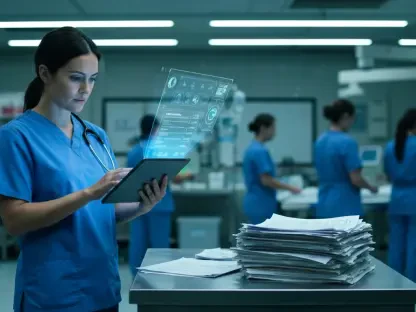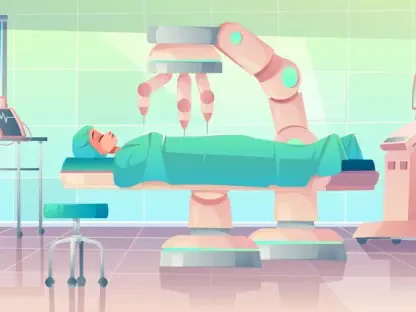Remote patient monitoring (RPM) and artificial intelligence (AI) are revolutionizing the healthcare landscape by enabling more personalized and effective patient care. These technologies are not only enhancing the way health data is collected and analyzed but also improving patient outcomes through tailored treatment plans and preventive measures.
The Evolution of Remote Patient Monitoring (RPM)
Real-Time Health Status Monitoring
Remote patient monitoring has evolved significantly with advancements in technology. Modern RPM devices and the Internet of Medical Things (IoMT) can continuously monitor vital signs such as weight, blood pressure, heart rate, glucose levels, and blood oxygen levels. This continuous data collection provides a comprehensive view of a patient’s health, unlike the sporadic data obtained during occasional doctor visits. The ability to monitor health in real-time allows for better trend analysis and more accurate baselines for individual patients.
The continuous collection of health data from RPM devices supports a more holistic approach to patient care. Instead of relying on the limited and often inconsistent data gathered during sporadic clinical visits, healthcare providers can now access a wealth of information that represents the patient’s day-to-day health status. Consequently, this allows for a dynamic and proactive approach to health management, where deviations from an individual’s norm can be detected promptly. Thus, RPM transforms the traditional static model of healthcare into a dynamic and responsive system, facilitating earlier interventions and more precise monitoring.
Personalized Treatment Plans
One of the key benefits of RPM is the ability to create personalized treatment plans. By understanding what is normal for an individual patient, healthcare providers can tailor treatments more effectively. For example, a slightly elevated temperature might be significant for one patient but not for another. This personalized approach helps in early intervention and customized care, ensuring that each patient receives the most appropriate treatment based on their unique health data.
Personalized treatment plans extend the capacity of RPM by enabling healthcare providers to make informed decisions based on patient-specific data. This approach eliminates the one-size-fits-all scenario and shifts the focus to individualized care. Such precision enhances the effectiveness of treatments and reduces the likelihood of unnecessary interventions. By establishing a patient’s baseline health parameters, RPM allows for an accurate comparison of current health data, alerting providers to any significant deviations that may require attention. This method aids in creating a more effective, patient-centric treatment regimen that continually adapts to the patient’s ongoing health needs.
Prevention and Early Detection
RPM tools are instrumental in the early detection of potential health issues. By continuously monitoring health data, these tools can identify changes that may indicate the onset of a condition, allowing for preventive measures to be taken. This proactive approach can reduce emergency visits, hospitalizations, and overall healthcare costs. With more data points available, healthcare providers can detect health changes sooner and initiate treatment before conditions escalate.
The ability to identify health issues early on significantly impacts patient outcomes and overall healthcare efficiency. Implementing preventive measures as soon as potential problems are detected helps in avoiding complications that could lead to more severe health conditions. Moreover, early intervention can lower healthcare costs by reducing the need for extensive treatments or emergency care. Patients benefit from improved health and quality of life while healthcare systems experience less strain from emergency cases. Thus, RPM’s capacity for early detection not only enhances individual patient care but also contributes to better resource management within the healthcare system.
Adoption and Application of RPM
Post-Discharge and Chronic Care Management
RPM is increasingly being used for monitoring patients post-discharge from hospitals and for managing chronic conditions. This technology is particularly beneficial in acute care recovery and chronic care management, where continuous monitoring can lead to quicker treatment adjustments and better patient outcomes. The application of RPM is also expanding in independent living and skilled nursing homes, where personalized care approaches can significantly improve patient wellness.
The seamless transition of care from hospital to home facilitated by RPM ensures that patients continue to receive the attention they need even outside the healthcare facility. For chronic disease management, RPM’s continuous data collection provides healthcare providers with ongoing insights into the patient’s condition, enabling timely adjustments to treatment plans. This ongoing monitoring is crucial for managing conditions like diabetes, heart disease, and hypertension, where consistent health metrics are vital for effective management. By integrating RPM into different healthcare settings, from post-discharge care to nursing homes, the scope of personalized care extends beyond traditional hospital boundaries, ensuring that patients receive comprehensive care.
Expanding Reimbursement Policies
The role of RPM in comprehensive patient health management is expected to grow with expanding reimbursement policies. As more healthcare providers adopt RPM, the financial incentives for using these technologies are becoming more favorable. This trend is likely to drive further adoption and integration of RPM into standard healthcare practices, making personalized and preventive care more accessible to a broader patient population.
Increased adoption of RPM technologies hinges significantly on favorable reimbursement policies. As insurance providers and government health programs recognize the long-term benefits of RPM—such as improved patient outcomes and cost reductions—these policies become more accommodating. The financial support enables healthcare facilities to invest in and implement RPM systems on a wider scale. As the technology becomes more accessible, patients from diverse backgrounds can benefit from advanced and personalized healthcare. Establishing sustainable reimbursement frameworks is crucial for transforming how healthcare is delivered, ensuring that more patients receive timely, customized care.
Data Maturity and Interoperability
Advancing Data Maturity
To effectively employ RPM, healthcare organizations must advance their data maturity. This involves developing the capability to handle large volumes of data generated by continuous monitoring. Current electronic health records (EHR) systems are not optimized for processing such data, necessitating improvements in data management and integration.
Healthcare IT departments need to adopt advanced data handling and storage solutions that can support the influx of information from RPM devices. Efficient data management requires scalable storage solutions and robust processing capabilities that can handle real-time data analysis. By investing in these technologies, healthcare organizations can ensure that they can process and utilize the data collected effectively. Without such advancements, the full potential of RPM may not be realized, as the sheer volume of data could overwhelm existing systems. Achieving data maturity, therefore, is foundational for leveraging RPM technology to its fullest extent, ensuring that patient data translation into actionable insights is seamless and effective.
Ensuring Interoperability with EHR Systems
Interoperability with EHR systems is crucial for the successful implementation of RPM. Healthcare IT teams need to focus on integrating data streams from RPM devices into EHRs to create actionable insights. This integration ensures that the valuable data collected through RPM is effectively utilized to enhance patient care and outcomes.
Successful integration of RPM data into EHR systems requires overcoming significant technical and operational challenges. The health information systems must be designed to communicate seamlessly with RPM devices, ensuring that data is not only received but also correctly classified and relevant to individual patient records. This requires robust APIs and interoperability standards that allow different systems to exchange data effortlessly. When RPM data becomes an integral part of the EHR, healthcare providers gain a more comprehensive view of the patient’s health history and current status. This holistic picture is vital for making informed clinical decisions and delivering personalized care. Therefore, a focus on interoperability is essential for leveraging the full capabilities of RPM in modern healthcare systems.
The Role of Artificial Intelligence (AI) in Enhancing RPM
Managing Data Deluge
AI and data analytics play a vital role in managing the vast amounts of data generated by RPM. These technologies assist in identifying significant health changes and trends that are beyond manual processing capabilities. By leveraging AI, healthcare providers can make quicker and more informed decisions, improving patient care.
AI holds particular value in transforming raw health data collected via RPM into meaningful insights. The capability of AI to analyze extensive data sets rapidly and detect patterns enables healthcare providers to focus on critical health indicators without being overwhelmed by data volume. For instance, AI algorithms can continuously monitor vital signs and identify abnormalities that may indicate deteriorating health conditions. By automating data analysis, AI eliminates the risk of human error in detecting subtle health changes, ensuring that no significant health event goes unnoticed. This technological synergy creates a more efficient and responsive healthcare system capable of real-time patient care improvements.
Predictive Care and Enhanced Decision-Making
AI tools integrate with RPM to predict health changes before they become critical. This predictive care approach allows for preemptive actions to manage patient health better. AI algorithms can process thousands of variables and data points, quickly identifying important patterns in vital signs, lab values, and social determinants of health. This rapid analysis supports faster, more accurate clinical decisions, enhancing overall patient care.
By leveraging predictive analytics, AI can foresee potential health crises before they materialize, allowing healthcare providers to intervene early. Predictive models analyze patient data sets to forecast potential complications, such as the likelihood of a heart attack in cardiac patients. This foresight enables medical teams to implement preventive measures, adjust medications, or make lifestyle recommendations to mitigate the risk. Enhanced decision-making backed by AI extends to all aspects of patient care, from diagnosis to treatment modifications. The result is a proactive healthcare approach, fundamentally shifting the paradigm from reactive to anticipatory care.
Resource Efficiency
With AI handling data analysis, healthcare professionals can focus more on patient engagement and care rather than data processing. This increased efficiency can lead to better patient outcomes and reduced healthcare costs. By automating data analysis, AI frees up valuable time for healthcare providers, allowing them to dedicate more attention to direct patient care.
Resource efficiency becomes a tangible benefit when AI is integrated into healthcare operations. By automating routine and complex data processing tasks, clinical staff are relieved from the burden of sifting through extensive data sets, thus lowering burnout and enhancing job satisfaction. This efficiency also translates into better allocation of healthcare resources, where time and skills are redirected towards patient-focused activities. Patients, in turn, benefit from enhanced interaction with their healthcare providers, leading to improved health outcomes and experiences. Moreover, the healthcare system itself becomes more streamlined, with AI optimizing operational workflows, thereby reducing unnecessary costs associated with data mismanagement and inefficient care delivery.
Data Governance and Storage Considerations
Ensuring Robust Data Governance
For successful RPM implementation, healthcare organizations must ensure robust data governance. Effective data management is crucial for leveraging patient-generated data for personalized and predictive care. This involves establishing clear policies and procedures for data collection, storage, and analysis to maintain data integrity and security.
Healthcare facilities must develop and implement stringent data governance frameworks to ensure RPM data integrity. This includes defining the protocols for how data is collected, who has access, how it is stored, and the methods of ensuring it remains secure. Policies must comply with regulations such as the Health Insurance Portability and Accountability Act (HIPAA), which mandates the protection of patient information. By maintaining high standards of data governance, healthcare organizations can safeguard against data breaches, errors, and misuses, thereby upholding patient trust. A well-structured data governance strategy not only enhances security but also ensures the data’s utility for clinical applications, driving better patient outcomes.
Partnering with Technology Firms
Partnering with experienced technology firms can help healthcare organizations devise and execute appropriate data strategies. Firms like CDW Healthcare offer resources and expertise to support organizations in their data journeys. They help design governance strategies suited to new RPM initiatives, ensuring that the people, processes, and technology align with organizational goals.
Collaborating with specialized technology partners provides healthcare organizations access to advanced tools and knowledge crucial for implementing sophisticated RPM and AI solutions. Partners bring valuable expertise in managing healthcare data, ensuring compliance with industry standards, and employing best practices in technology integration. These collaborations enable healthcare providers to focus on core clinical functions while relying on their partners to manage the technological complexities. Through strategic partnerships, healthcare institutions can accelerate the adoption of RPM and AI technologies, streamline their operations, and enhance their capacity to deliver personalized and efficient care.
Support from Technology Partners
Role of Technology Partners
Technology partners, with a deep understanding of healthcare needs, play an essential role in supporting the adoption and scaling of RPM and IoMT solutions. Organizations like CDW Healthcare offer strategists experienced in various healthcare environments, providing valuable resources to support healthcare providers in their data journeys. They help design governance strategies suited to new RPM initiatives, ensuring that the people, processes, and technology align with organizational goals.
Firms with vast experience in healthcare technology offer crucial support in navigating the complexities of RPM and AI integrations. These partners provide tailored solutions that address specific organizational needs, considering factors such as existing infrastructure, patient demographics, and regulatory requirements. They assist in developing scalable and secure data management systems that can handle the vast amounts of data generated by RPM devices. Additionally, they provide training and support to ensure that healthcare staff can effectively use these advanced technologies. The collaboration with technology partners enables healthcare providers to leverage cutting-edge solutions, thus optimizing patient care and operational efficiency.
Conclusion and Implications for Healthcare
Remote patient monitoring (RPM) and artificial intelligence (AI) are transforming the healthcare industry, leading to more personalized and efficient patient care. These cutting-edge technologies are significantly advancing how health data is gathered, analyzed, and utilized, creating a shift towards more proactive rather than reactive care models. RPM allows continuous monitoring of patients’ health metrics from the comfort of their homes, reducing the need for frequent hospital visits, which can be both time-consuming and costly. AI, on the other hand, assists in processing vast amounts of health data, identifying patterns and predicting potential health issues before they become critical. This synergy between RPM and AI enables healthcare providers to develop customized treatment plans tailored to individual patient needs, focusing on preventive measures and early interventions. The integration of these technologies is not only enhancing patient outcomes but also streamlining healthcare operations, reducing costs, and ultimately making healthcare more accessible and effective for all.









